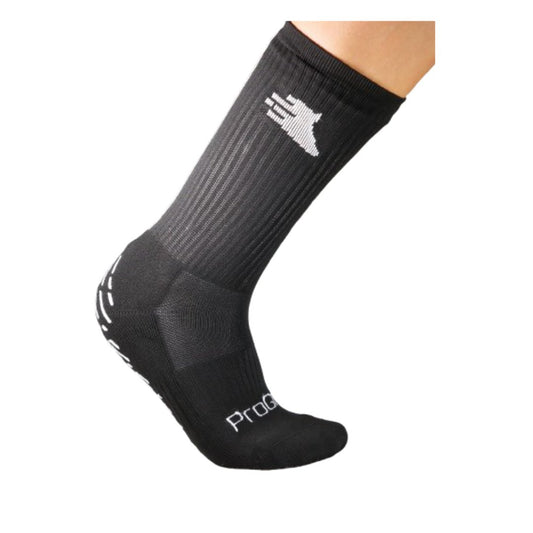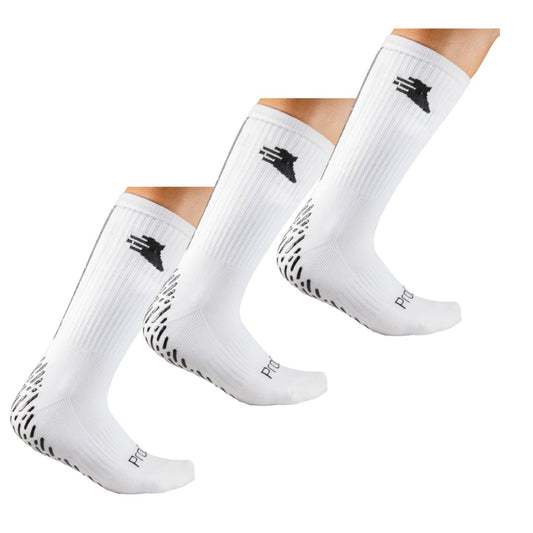Grip socks have been gaining popularity among athletes for their ability to enhance stability, prevent slips, and improve comfort during physical activities. But if you’re an athlete or sports enthusiast, you may have one important question: Are grip socks allowed in sports?
The short answer is: Yes, grip socks are generally allowed in most sports, but there are some considerations to keep in mind depending on the sport and the specific rules of the event or competition. In this blog, we’ll explore the reasons why grip socks are becoming a must-have for athletes, as well as the instances where they might not be allowed.
Why Grip Socks Are Becoming a Must-Have in Sports
Before diving into the question of whether grip socks are permitted in specific sports, let's first take a look at the benefits they offer.
1. Improved Stability and Control
Grip socks feature non-slip soles that help athletes maintain better traction during their movements. Whether you're running, lifting, or playing a team sport like football or basketball, these socks can help you stay stable, avoid slipping, and maintain better foot control, which can enhance your overall performance.
2. Comfort and Protection
By providing extra cushioning and reducing friction, grip socks help prevent blisters and discomfort, especially during long practice sessions or games. This added comfort can make a huge difference, particularly in sports that involve repetitive movement or foot strain.
3. Hygiene and Safety
In many indoor sports or fitness settings, grip socks are often used for hygiene reasons. They act as a barrier between the athlete’s foot and gym equipment or mats, helping to reduce the risk of infections or athlete's foot, which can be a concern in shared spaces like locker rooms or gym floors.
Are Grip Socks Allowed in Team Sports?
Football
In football, the use of grip socks is generally allowed, as long as they do not interfere with the performance of the cleats or other official gear. Many professional and amateur players wear grip socks under their cleats to reduce foot slippage and maintain a secure fit. However, it’s always essential to check with the governing body or league to make sure there are no specific regulations that prohibit or restrict grip socks in competitive play.
In some cases, the primary concern might be the thickness or structure of the sock. If the grip sock is too bulky and affects the fit of the cleat, it could be a potential issue. But in general, grip socks are acceptable as long as they don't violate uniform standards.
Basketball
Grip socks are also widely accepted in basketball. They are especially useful for improving traction on indoor courts, where players are constantly making quick cuts, pivots, and jumps. While some professional leagues may have specific uniform guidelines, grip socks are typically seen as a useful tool for enhancing performance and comfort. However, always ensure the socks don’t interfere with the design or look of the team’s uniform.
Soccer
Much like football, soccer players often wear grip socks under their cleats to prevent slipping and to enhance comfort during long matches. As long as the socks don’t conflict with league regulations or the design of the uniform, grip socks are generally allowed in both recreational and competitive soccer. However, always check with the league or tournament organizers, especially for competitive play, to ensure there are no restrictions.
Rugby, Hockey, and Other Contact Sports
In contact sports like rugby or hockey, grip socks are allowed, but they must be worn in a way that doesn’t interfere with the equipment or endanger safety. As with other team sports, the primary concern would be whether the socks affect the fit of the footwear or uniform.
Grip Socks in Individual Sports
Running
Grip socks are allowed in running, especially for indoor training, like on a treadmill or track, where stability is key. While grip socks aren’t typically needed for outdoor running (as most running shoes provide sufficient grip), they are a great option for anyone who wants extra stability during indoor workouts. Some competitive runners may choose to wear them for additional comfort and performance on indoor tracks or during warm-ups.
Yoga and Pilates
Grip socks are widely used in activities like yoga and Pilates. These disciplines require strong footing and control to maintain various poses and postures. Grip socks are essential here, as they help reduce the risk of slipping on mats, making them highly recommended for both beginners and advanced practitioners. Many studios even encourage the use of grip socks for hygiene reasons.
Cycling
In cycling, grip socks can be a useful addition, especially for indoor cyclists or those using stationary bikes. The added traction helps keep your feet secure in cycling shoes, preventing any movement or slippage while pedaling. However, on outdoor bikes, grip socks are generally not necessary since cycling shoes already provide adequate grip with cleats and pedals.
Are Grip Socks Allowed in Competitive Sports?
The main concern regarding grip socks in competitive sports is whether they meet specific uniform or gear guidelines set by the sport’s governing bodies. For example, in some sports, there are strict rules about footwear, and certain socks or shoe inserts may not be permitted if they alter the official equipment.
For instance, the FIFA (international governing body for soccer) may have specific regulations about the use of socks under cleats, especially if the socks alter the fit or safety of the footwear. Similarly, professional leagues like the NFL (National Football League) or NBA (National Basketball Association) may have detailed uniform policies, and athletes should ensure that their grip socks meet these standards.
However, for most recreational and amateur sports, grip socks are widely accepted and appreciated for their benefits in terms of performance, comfort, and safety. It’s always a good idea to check the official rules and regulations of your league, tournament, or event to ensure compliance.
Final Thoughts
Grip socks are a fantastic option for athletes in a wide range of sports, offering increased traction, comfort, and stability. While they are generally allowed in most sports, there may be specific rules or regulations depending on the competition level and the governing body of the sport.
If you’re unsure about the rules for your specific sport, always double-check with your coach, league officials, or tournament organizers to ensure compliance. Overall, grip socks provide an excellent way to enhance performance and prevent injuries, making them a valuable addition to any athlete’s gear, regardless of the sport.
If your looking for some high quality Grip Socks that stand out to their competitors, check out ProGrip socks for the best in the market!





